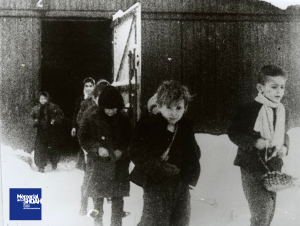76th anniversary of the liberation of the Auschwitz-Birkenau camps

Credits and legend:
Deported women and children, survivors of the Auschwitz camp, leaving a barracks, after the liberation of the camp. Poland, after 01/27/1945
© Shoah Memorial
On January 27, 1945, in the morning, an avant-garde of Soviet scouts arrives in the area of the Auschwitz complex and discovers the Auschwitz-III Monowitz camp. In the afternoon, the Auschwitz-Birkenau camps and then the main Auschwitz-I camp are successively reached.
The Red Army knew that a vast military-industrial zone was on the spot, but existing information about the mass crimes committed was not communicated to the units in the field. No more for Auschwitz than for the other camps, in the East as well as in the West.
7,000 survivors are still present, including 200 children rescued from pseudo-scientific experiments. The Nazis failed to execute or remove them during the "death march".
As the front approached, the SS had launched on 17 January the evacuation of the Auschwitz camps and the external kommandos. Until 20 January, 58,000 already stretched and weakened prisoners are forced to leave on the snowy roads for other concentration camps in central Germany. Until the end, the Third Reich intends to use this workforce in the service of the «total war». Thousands of detainees die during these transfers, mainly to the camp at Buchenwald, Bergen-Belsen, Dachau and Mauthausen.
The soldiers survey the Kanada-II in flames, the barracks from which rare silhouettes emerge, the ruins of the dynamited crematories, whose gas chambers had been dismantled during the previous months. The traces of genocide had to be masked as much as possible, the archives for many destroyed, the witnesses killed or removed by force.
The soldiers mainly discover hundreds of corpses, massacred by the SS or dead from exhaustion and diseases in the previous days. As in Majdanek, mountains of personal belongings attest to mass crimes: 7 tons of hair, more than a million clothes of men, women and children, thousands of pairs of shoes, glasses and objects of all kinds...
January 27, 1945 does not mark the end of the genocide of the Jews and the ordeal of the deportees will only come to an end with the fall of the Third Reich in 1945. But their sufferings and those of the families of the disappeared will continue well beyond, like the time necessary for the awareness of the singularity of the Shoah.
In 2005, 27 January became the International Day of Remembrance for the Victims of the Holocaust by decision of the United Nations.
Discover the materials around this 76th anniversary

